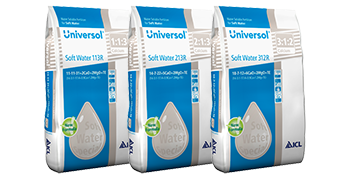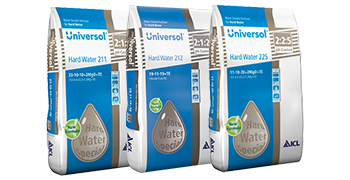Water soluble fertilisers provide a convenient and effective means to deliver balanced nutrition to your plants. When it comes to new sustainable growing media mixes, applying water soluble fertiliser efficiently and effectively can present challenges, however these can be overcome by using the correct water soluble product – says ICL technical area sales manager Carl Mason.
Here Carl provides advice and tips on how to negate potential issues by tailoring irrigation and using the right technically advanced water soluble product - suited to the nursery’s water quality.
Greater nutrient leaching risk
Compared to traditional peat-based mixes, sustainable mixes containing woodfibre, bark and coir tend to have lower water holding capacity. This means less irrigation water is held in the pot at field capacity. Coupled with a lower CEC (cation exchange capacity), which means less nutrients are held on the media surface, there is a greater risk of nutrient leaching.
I’ll start with a few tips on how to minimise leaching in general.
Irrigation type: Be mindful that overhead irrigation leads to greatest leaching, while capillary and drip irrigation less so.
Pot spacing: Using overhead irrigation with spaced pots can be very inefficient, drip irrigation is significantly more efficient.
Adjusting irrigation controllers: It is a good idea to use more frequent irrigation cycles and shorter application times as this can significantly reduce losses and therefore costs. However, it is important to monitor pot moisture closely and water only when required. With sustainable growing media, the pot surface is generally drier. It is therefore a good idea to pick up pots, to assess their weight, to quickly establish if they actually need watering.
Use a wetting agent: Products such as H2Gro increase the water holding capacity of growing media. Facilitating more efficient rewetting, it results in savings not only in water but also water soluble feeds.

Deficiency symptoms
Compared to traditional peat growing media mixes, sustainable mixes typically require the addition of up to 70% less lime to balance the pH. This in turn means Calcium and Magnesium levels are lower. The upshot is that the potential for deficiencies within the crop is significantly increased, particularly if the water source is soft – ie low in essential nutrients.
Calcium is immobile within the plant and deficiencies quickly show up in the growing tips and new leaves - which start to cup while the edges go brown. Conversely, Magnesium is highly mobile with deficiency symptoms first appearing in older leaves as a yellowing between the leaf veins - giving a Christmas tree effect.
Staying one step ahead
In help avoid these issues, ICL recommends nurseries take an annual water sample to check the water quality and fine tune nutrient programmes accordingly.

To stay one step ahead, we recommend using a technically advanced soft water feed. From our standard range we offer a choice of three Universol Soft Water products - targeting different growth stages. Alternatively, from our optimum feeding range we offer Peters Excel CalMag Grower or Finisher to overcome soft water issues. Meanwhile, to tackle an actual Calcium or Magnesium deficiency issue, use our fast-acting Peters Foliar Feed for a quick ‘green up’ - restoring vitality to the plant.
Hard water challenge
Hard water poses a different challenge. The low CEC of sustainable growing media means the high bicarbonate levels in the hard water can more easily raise the growing media pH above the optimum (5.5 to 6.0) towards 6.5 and above. Left unchecked, this can lower the availability of some nutrients - particularly trace elements.
As pH rises, the most common deficiency is Iron – which is immobile. Iron deficiencies appear in the growing points and new leaves as an interveinal chlorosis, eventually leading to pale and bleached leaves. Symptoms are initially similar to Magnesium deficiency but located in the new leaves.

For growers using hard water, to avoid Iron deficiency issues we recommend feeding regularly with a product from our standard Universol Hard Water or optimum Peters Excel Hard Water ranges. Meanwhile, an actual deficiency can be rectified using our fast-acting Peters Foliar Feed.
Here to help
The ICL technical team is here to help growers optimise nutrient plans to avoid these problems. As well as a team of FACTS and BASIS qualified technical area sales managers, we employ our precision nutrition Angelaweb 3.0 software to deliver the best programmes, based on factors such as crop demand, water quality and growing media mix. These bespoke nutrition programmes incorporate water soluble and / or controlled release fertilisers as appropriate.
You can learn more about Water Soluble fertilizers at Hort Science Online 2023.
